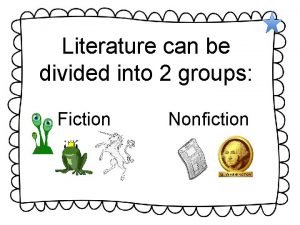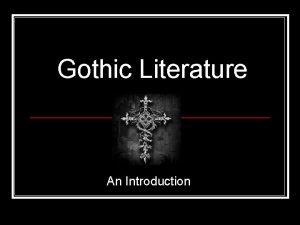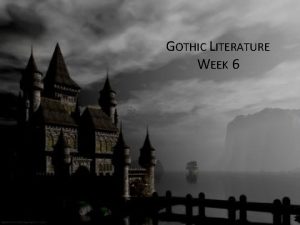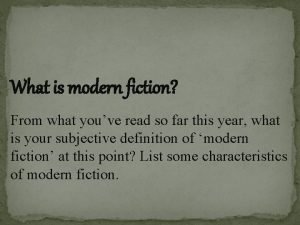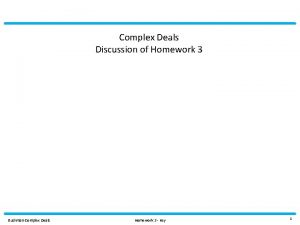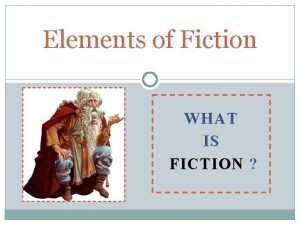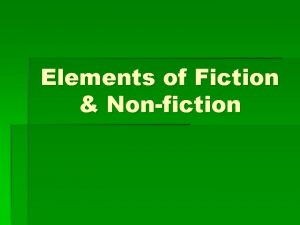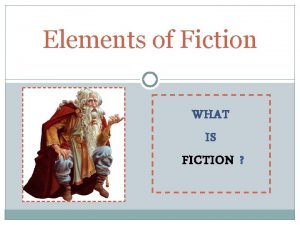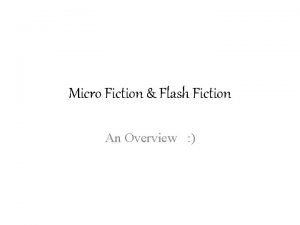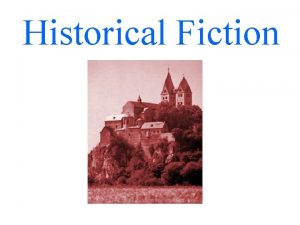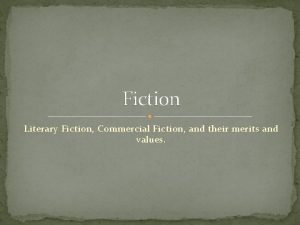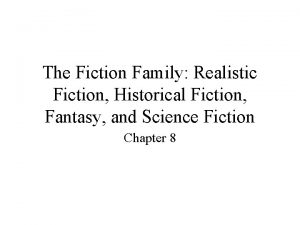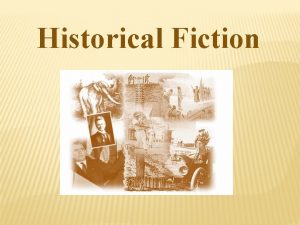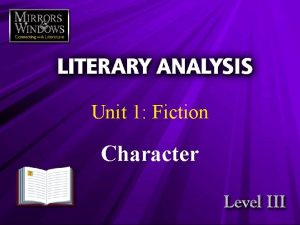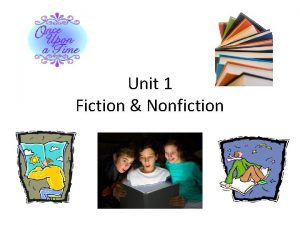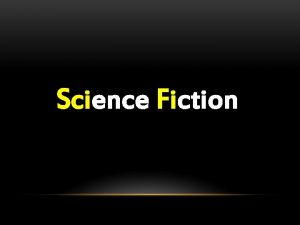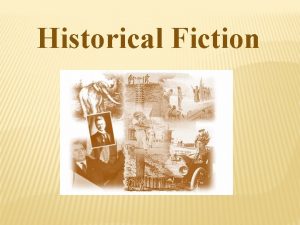FICTION Fiction The kind of literature that deals






























- Slides: 30

FICTION

Fiction The kind of literature that deals with events that are not true at the time of writing

Subdivisions of Fiction • By form: legends, comics, fables, fairy tales, film, folklore, novels, plays, poetry, s erials, short stories, situation comedies, and video games. • Age group: children’s literature, youngadult fiction, adult fiction (including pornography and erotica)

Subdivisions of Fiction • By content: – Amalgamation (fiction): a combination, of several other previously existing characters or locations – Christian Fiction: any novel that expounds and illustrates a Christian world view in its plot, its characters, or both, or which deals with Christian themes in a positive way. – Detective fiction: ranch of crime fiction in which a detective (or detectives), either professional or amateur, investigates a crime, often murder. – Fan fiction: is a broadly-defined term for fan labor regarding stories about characters or settings written by fans of the original work, rather than by the original creator – Fantasy fiction: a genre that uses magic and other supernatural forms as a primary element of plot, theme, and/or setting – Genre fiction: also known as popular fiction, is a term for fictional works (novels, short stories) written with the intent of fitting into a specific literary genre in order to appeal to readers and fans already familiar with that genre {action-adventure, crime, detective, fantasy, horror, mystery, romance, science fiction, western, literary fiction}

Subdivisions of Fiction • By Content – Historical fiction: a sub-genre of fiction that often portrays fictional accounts or dramatization of historical figures or events – Horror fiction: a genre of fiction in any medium intended to scare, unsettle and horrify the audience. Historically, the cause of the "horror" experience has often been the intrusion of a disturbing supernatural element into everyday human experience. – Mystery fiction: is a loosely-defined term that is often used as a synonym for detective fiction or crime fiction— in other crying words a novel or short story in which a detective (either professional or amateur) investigates and solves a crime – Paranoid fiction: term sometimes used to describe works of literature that explores the subjective nature of reality and how it can be manipulated by forces in power

Subdivisions of Fiction • By Content – Romance fiction: a genre of medieval and renaissance narrative fiction – Science fiction: a genre of fiction. It differs from fantasy in that, within the context of the story, its imaginary elements are largely possible within scientifically established or scientifically postulated laws of nature – Western fiction: a genre of literature set in the American Old West frontier (usually anywhere west of the Mississippi River) and typically set during the late nineteenth century

Subdivisions of Fiction • By length: – Flash fiction: a work of fewer than 2, 000 words (1, 000 by some definitions) (around 5 pages) – Short story: a work of at least 2, 000 words but under 7, 500 words (5– 25 pages) – Novelette: a work of at least 7, 500 words but under 17, 500 words (25– 60 pages) – Novella: a work of at least 17, 500 words but under 50, 000 words (60– 170 pages) – Novel: a work of 50, 000 words or more (more than 170 pages),

Basic Elements of Fiction • Character – A character is any person, persona, identity, or entity that exists in a work of art. Characters may be entirely fictional or based upon real, historical entities (see Historical fiction). Characters may be human, supernatural, mythical, divine, animal, or personifications of an abstraction. Characterisation is the process of creating an image of a person in fiction, complete with that person's traits, features, and motivation. • Plot – Plot is a sequence of interrelated events arranged to form a logical pattern and achieve an intended effect. It is often designed with a narrative structure or storyline, that includes conflict, rising action, and climax, followed by a falling action and a resolution or dénouement. • Setting – Setting, the location and time of a story, is sometimes referred to as story world or to include a context (such as society) beyond the immediate surroundings of the story… In some cases, setting becomes a character itself and can set the tone of a story.

Basic Elements of Fiction • Theme – The theme of a story is the point the writer wishes to make, a moral or conceptual distillation of the story often posed as a question or human problem. • Style – Style is not so much what is written, but how it is written. In fiction, style refers to language conventions and literary techniques used to construct a story. The communicative effect created by an author's style is sometimes referred to as the story's voice. Each writer has his or her own unique style, or voice.

Basic Elements of Fiction There are still other elements that you need to be aware of. However, what was given earlier are just the very basics in making stories

Short Stories • a work of fiction that is usually written in prose, often in narrative format • Short stories have their origins in oral story-telling traditions and the prose anecdote, a swiftly-sketched situation that quickly comes to its point. • With the rise of the comparatively realistic novel, the short story evolved as a miniature version, with some of its first perfectly independent examples in the tales of E. T. A. Hoffmann. • Other nineteenth-century writers well-known for their short stories are Nathaniel Hawthorne, Herman Melville, Edgar Allan Poe, Nikolai Gogol, Guy de Maupassant, Bolesław Prus and Anton Chekhov. • Short stories were a staple of early-19 th-century magazines and often led to fame and novel-length projects for their authors. More recently, short stories have been reprinted in anthologies, categorized by topic or critical reception. Today many authors release collections of their short stories.

Setting • The place where the story takes place – Geographical location – Time period – Socio-economic characteristics of the location – Specific building, room, and the likes

Setting • Uses of setting – tell readers about the characters – Set the atmosphere of the story

Characters • The people, animal, things, and the likes presented in a literary work – Round – Dynamic – Flat – Static – Protagonist – Antagonist

Methods of Characterization • Direct characterization – the author develops the personality of a character by direct statements • Indirect characterization – Thoughts, words and actions – Comments of other characters – Physical appearance

Plot • Structure of the story • Arrangement of events and actions in a story • Plot components – Exposition – Rising action – Climax – Falling action – Resolution

Plot • Exposition – the start of the story, the situation before the action starts • Rising action – the series of conflicts and crisis in the story that lead to the climax • Climax – the turning point, the most intense moment – either mentally of in action • Falling action – all of the action that follows the climax • Resolution - the conclusions, the tying together of all the threads

Plot • Conflict – the dramatic struggle between two forces in the story; • no conflict, no plot – Human vs. human – Human vs. nature – Human vs. society – Human vs. himself

Point of view • The perspective from which the story is told – Who is telling the story? – How do we know what is happening? • Different kinds of POV – Omniscient – Limited omniscient – 1 st person

Theme • The central idea or central message in the story. It usually contains some insight into the human condition – telling something about humans and life. • The theme can be stated directly or implied by the events and actions in the story.

Symbolism • A symbol represents and idea, quality or concept larger than itself – Examples: • • Journey – life Lion – courage Water – cleanliness or renewal Red rose - love

Quiz • • • (1 -4)Different kinds of setting (5 -6)Difference between round and flat character (7 -8)Difference between static and dynamic (9)What is a stock character? (10 -11)Two forms of characterization (12 -15)Parts of a plot (16) Example of a point of view (17) Discuss what is theme (18) Discuss what is symbolism

Excuses "But Mom, you promised!" "I know dear, but things don't always work out the way we planned. " After an extremely exhausting day at the office, the last thing I wanted to do right now was go swimming. "But Mom, you promised!" "I know, but I'm just too tired. Maybe we can go tomorrow instead. " "You never keep your promises. " "Yes I do. Sometimes it takes me awhile to keep them, but you know we will eventually go swimming. " "But you said we could go today. " "And when tomorrow is today, we will. " "Oh alright, but don't forget you promised. " "Don't worry dear, I won't" As I settled down to relax for awhile, I marvelled at the general stupidity of mothers. Why we insist on teaching our children things like "you should never tell a lie, " and "you should always keep your promises" is a mystery. We all know it will come back to haunt us eventually. Perhaps we are all somewhat masochistic, and need to have the occasional guilt trip laid on us by our children when we don't live up to our own expectations. Whatever the reason, I would welcome a course in creatively "skirting the issue and confusing your children. " Just think, when my children are grown and gone, I could quit my office job and run for politics. Maybe I could start an advice column for families, or write books on creative parenting, or. . . I sighed as I suddenly realized, visions of grandeur aside, I still have ten years of excuses to go!

We Don't Need Oxygen We met this fellow at the airport who had a large dagger of a nose and halitosis. He booked his holiday, right there and then, over the Internet. He phoned his wife and told her he was going on holiday for a week and then got on the plane. Just like that. I don't know what she said. He slept beside the pool because he was too drunk to walk up to his room. He went over to Skiathos for three days where he had sex with a couple of birds. Then he came back to the island carried on sleeping by the pool inbetween drinking cheap ouzo and eating olives and feta. He bought 200 cigarettes for his wife. I don't know what she said.

How My Brother Leon Brought Home A Wife • He enrolled at the University of the Philippines in 1926. As a means to support his studies, he worked as a writer and printing assistant at the Carmelo and Bauermann office, and as an editor of the Literary Apprentice. • Arguilla also became a member of the UP Writers Club and presided over it from 19321933. In 1933, he obtained the degree of Bachelor of Science in Education.

How My Brother Leon Brought Home A Wife • Manuel Estabillo Arguilla (1911 -1944) was an Ilokano writer in english, patriot and martyr • He was born in Barrio Naguilian, Bauang, La Union on June 17, 1911. He was the fourth son of Crisanto Arguilla and Margarita Estabillo. His father was a carpenter and farmer while his mother was an occasional potter.

How My Brother Leon Brought Home A Wife • Arguilla often portrayed the life of the ordinary Ilocano farmer in his short stories. Stories about farmers, rural scenes and the Ilocano way of life can be read in Arguilla's stories. His more than 50 short stories have enriched Philippine literature. The critic Dean Leopoldo Yabes cited him as “the best craftsman among Filipino fictionists in English, (whose voice) is the only really authentic voice. He is shamelessly Filipino. ” Even foreigners will be amazed at Arguilla's talent in vividly weaving and creating sentences and paragraphs. One of his famous sentences can be found in the short story “How My Brother Leon Brought Home A Wife” when he described the fragrance of Maria as "like a morning when papayas are in bloom. " • On June 12, 1972, Arguilla was honored with a posthumous award, the Republic Cultural Heritage Award. The award cited his effort in producing literary works that have “continued to influence Filipino fiction writing. . . and literary scholarship. ” In gratitude for his contribution to Philippine literary advancement, a marker was installed in his hometown on August 25, 1983.

How My Brother Leon Brought Home A Wife • He is known for his widely anthologized short story "How My Brother Leon Brought Home A Wife, " the main story in the collection How My Brother Leon Brought Home a Wife and Other Short Stories which won first prize in the Commonwealth Literary Contest in 1940. His stories entitled "Midsummer" and "Heat" were published in the United States by the Prairie Schooner. • His other works include the short stories "Morning in Nagrebcan", "Ato", "A Son Is Born", "The Strongest Man", "Mr. Alisangco", "Though Young He Is Married", "The Maid, the Man, and the Wife, " "Elias, " "Imperfect Farewell, " "Felisa, " "The Long Vacation, " "Caps and Lower Case, " "The Socialists", "Epilogue to Revolt", "Apes and Men", and "Rice".

How My Brother Leon Brought Home A Wife • How My Brother Leon Brought Home A Wife is a story written by Manuel Arguilla about a man who comes home to his province to introduce his wife from the city to his family. This short story won first prize in the Commonwealth Literary Contest in 1940. • Baldo and his older brother Leon were both waiting for the arrival of their visitor riding the carretela. Seeing his brother's wife, Baldo was easily taken away by the beauty of the woman from city as he narrates their journey to Nagrebcan. The idea of meeting with Leon's parents for the first time made Maria a bit anxious. But along their way home, Maria discovered the peculiarities of the life in Nagrebcan as opposed to their life in the city where she met and fell in love with Leon.

How My Brother Leon Brought Home A Wife • How My Brother Leon Brought Home A Wife is a story written by Manuel Arguilla about a man who comes home to his province to introduce his wife from the city to his family. This short story won first prize in the Commonwealth Literary Contest in 1940. • Characters – Baldo - younger brother of Leon, fetched Leon and Maria from the road to Nagrebcan – Leon (or Noel) - older brother of Baldo who studied in Manila where he met his wife – Maria - the beautiful and stunning wife of Leon from Manila – Labang - the bull whom Baldo considers as his “pet” – Norman Tabios - Maria's ex-boyfriend who happened to be a loro – Gagambino - Leon's favorite fictional character who gave him lots of guts to study in Manila – Churita - Labang's girlfriend/fiance
 Tìm vết của mặt phẳng
Tìm vết của mặt phẳng Sau thất bại ở hồ điển triệt
Sau thất bại ở hồ điển triệt Thơ thất ngôn tứ tuyệt đường luật
Thơ thất ngôn tứ tuyệt đường luật Hãy nói thật ít để làm được nhiều
Hãy nói thật ít để làm được nhiều Thơ thất ngôn tứ tuyệt đường luật
Thơ thất ngôn tứ tuyệt đường luật Tôn thất thuyết là ai
Tôn thất thuyết là ai Ngoại tâm thu thất chùm đôi
Ngoại tâm thu thất chùm đôi Chiến lược kinh doanh quốc tế của walmart
Chiến lược kinh doanh quốc tế của walmart Gây tê cơ vuông thắt lưng
Gây tê cơ vuông thắt lưng Block nhĩ thất cấp 1
Block nhĩ thất cấp 1 Contemporary realism literature
Contemporary realism literature Fiction vs nonfiction
Fiction vs nonfiction Science fiction is a genre of speculative fiction dealing
Science fiction is a genre of speculative fiction dealing What are the elements of fiction and nonfiction
What are the elements of fiction and nonfiction Gothic book genre definition
Gothic book genre definition Define gothic literature
Define gothic literature What is modern fiction
What is modern fiction Thiếu nhi thế giới liên hoan
Thiếu nhi thế giới liên hoan Tia chieu sa te
Tia chieu sa te Một số thể thơ truyền thống
Một số thể thơ truyền thống Các môn thể thao bắt đầu bằng tiếng chạy
Các môn thể thao bắt đầu bằng tiếng chạy Hát kết hợp bộ gõ cơ thể
Hát kết hợp bộ gõ cơ thể Hệ hô hấp
Hệ hô hấp Số nguyên là gì
Số nguyên là gì đặc điểm cơ thể của người tối cổ
đặc điểm cơ thể của người tối cổ độ dài liên kết
độ dài liên kết Trời xanh đây là của chúng ta thể thơ
Trời xanh đây là của chúng ta thể thơ Gấu đi như thế nào
Gấu đi như thế nào ưu thế lai là gì
ưu thế lai là gì Thẻ vin
Thẻ vin Tư thế ngồi viết
Tư thế ngồi viết











